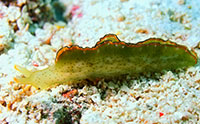Detailed inspection of a Saturn moon now shows not just one, but 101 geysers shooting ice particles into space. If these geysers formed billions of years ago they should be old, cold, and dead—that is, completely inactive. Why aren’t they? More… …read more Read more here: icr.org
In an everyday scene so bizarre that science fiction writers might never have imagined it, algae-eating sea slugs actually hijack chloroplasts—those tiny plant structures that perform photosynthesis—and use them as energy producers for themselves. Evolutionists have been trying to explain this complicated and baffling process. Have they? More… …read more Read more here: icr.org
Published: 11 November 2009 A salamander allegedly “18 million years old” is the latest fossil to produce astonishingly well preserved soft tissue. This time, it’s muscle tissue, and it is supposedly the most pristine example yet. M. H. Schweitzer The muscle and blood found in the salamander fossil are the latest soft-tissue evidence in a long line of similar discoveries. Earlier, these flexible branching structures in T. rex bone (left photo) have justifiably been identified as blood vessels, while microscopic structures squeezed out of the blood vessels (right photo) look distinctly like cells, as evolutionary researchers themselves have admitted. (See [More]
The geological history of Brisbane and Ipswich Australia from a biblical perspective. One of the values of history is that it helps us understand where we have come from and so appreciate our place in the world. Our view of the past will inform the choices we make today, which also shape our future. Especially significant is our understanding of geological history, which provides the broadest and most basic picture of where we fit into the world. George Orwell said, “He who controls the past controls the future. He who controls the present controls the past.”1 How true. There [More]
Get used to seeing feathers on all evolutionary depictions of dinosaurs, not just theropods! …read more Read more here: AIG Daily
Many dinosaur fossils include real bone—they are not completely mineralized, i.e. are not yet ‘rock’. And what is found inside those dinosaur bones is a huge surprise to many people. A series of discoveries since the early 1990s has revealed dino bones with blood cells, hemoglobin, fragile proteins, and soft tissue such as flexible ligaments and blood vessels. And of special note: DNA and radiocarbon. This is enormously confronting for evolutionists, because how could such bones possibly be 65 million years old? As one of the researchers involved in the discovery of dinosaur blood cells, Dr Mary Schweitzer, said: Why [More]
Numerous fossil remains ‘dated’ as being many millions of years old are hardly mineralized (i.e. where minerals take the place of the creature’s original tissue), if at all. For example, Tyrannosaurus rex bones containing red blood cells and soft ‘squishy’ tissue boggle the minds of those who claim that dinosaur remains are 65 million years old, at least.1 Such soft tissue finds utterly contradict the widely believed old age of the earth.2 And now, a new find exceeds all previous claims for persistence of the remains of dead creatures to the present day—that is, according to the mind-stretchingly bizarre pre-Cambrian [More]
A pterosaur fossilized-in its egg! What would you think? …read more Read more here: creation.com
There are many strange creatures living in the sea, but few stranger than the Nudibranch Sea Slug. And there are few whose design is more damaging to the theory of evolution. Sea slugs mainly eat sea anemones, which are covered with stinging cells that normally burst at the slightest touch, firing poison darts at the creature which touched them. The sea slug, however, is able to tear sea anemones apart and swallow the stinging cells without bursting them! Wikipedia.org, Nick Hobgood Nudibranchs (Nembrotha kubaryana) eating clavelina tunicatecolonies. Even more amazing is what happens to the stinging cells when they reach the [More]
While bats live in air and dolphins live in water, both use a biological form of sonar technology called echolocation to see with sound! The specifications in dolphin and bat biosonar systems are so many, so well-integrated, and so precise, could they really have developed at random in two completely different environments? More… …read more Read more here: icr.org
Does the Bible really teach a 6,000 year old creation? And is there good evidence that the earth is older than that? …read more Read more here: creation.com
An international team of scientists discovered a new fossil in Chinese sediments famous for their supposed feathered dinosaur specimens. Like a handful of previous finds, this new example apparently had four wings. Fossil impressions show flight feathers extending not only from the front wings of Changyuraptor yangi, but also from a pair of hind wings, making this the largest four-winged creature yet found in fossils. More… …read more Read more here: icr.org
The latest conclusion from big bang cosmologists is that our universe doesn’t exist! …read more Read more here: creation.com
The eleven-year Hell Creek Project involved collecting fossils from the famous Montana Hell Creek Formation, including over fifty Triceratops specimens. The latest report from the project, however, reveals three “logic holes” in its attempts to answer questions about when and how these dinosaurs evolved. More… …read more Read more here: icr.org
Who has ever heard of a fossilized brain? Few would expect such a discovery, yet it looks like that’s what researchers found inside a Stone Age skull from Norway. If so, it would confirm a published creation prediction and challenge many evolutionary timescales. More… …read more Read more here: icr.org
Is there an evolutionary advantage to having a mode of swimming like this? …read more Read more here: creation.com
NASA promoters discussed the hope of discovering life on other planets at a recent meeting in NASA headquarters. Despite billions of dollars spent over the decades-long search and the fact that not one shred of distant life evidence has been found, NASA continues to suggest that life might really be out there and that its discovery is within reach. More… …read more Read more here: icr.org
The question about the origin of matter and the energies we observe in action is already answered in the first verse of the Bible. …read more Read more here: AIG Daily
Agents of the ‘Black Death’, these much-despised rodents very clearly did not have a non-rodent ancestor. …read more Read more here: creation.com
What a storm it must have been! News reports said that hundreds of giant jellyfish once lived about 500 million years ago, but were ‘stranded by a freakish tide or storm’ on an ancient beach. Sand later buried them, forming fossils.1,2 With many specimens measuring over 50 cm (20 in) across, these are the biggest fossil jellyfish known. Found in a Wisconsin sandstone quarry, it must have been an extraordinary set of circumstances that preserved them, geologists say, for fossilized impressions of jellyfish, which have no skeleton or other hard parts, are extremely uncommon.3 “To preserve a jellyfish, that’s hard, [More]
Australopithecine’s fatal fall preserved this fine fossil in a post-Flood cavern collapse. …read more Read more here: AIG Daily
Does the hyena deserve its ‘cowardly and villainous’ reputation? …read more Read more here: creation.com
These uniquely designed creatures continue to defy evolutionary explanation … …read more Read more here: creation.com
Astrophysicists in damage control after big-bang ‘find’ doesn’t stand up to scrutiny. …read more Read more here: creation.com
Did the universe create itself from nothing? …read more Read more here: creation.com
Genesis 5:5 says Adam lived for 930 years. Judging by today’s standards, this sounds impossible. Many contemporary readers of Genesis balk at such numbers and some end up rejecting the whole Bible. But a few researchers have found reasons to believe it. More… …read more Read more here: icr.org
Rapidly formed fossils, and many that still contain carbon-14, defy the conventional wisdom of millions of years. …read more Read more here: creation.com













































